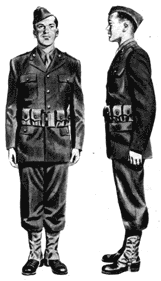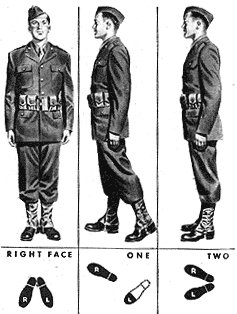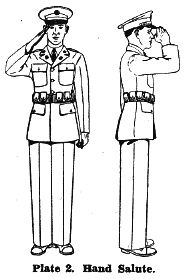|
|||
|
|||
from Tactics & Technique of Infantry, Basic, 1942
Additional Images from Army Life, 1944
Contents:
1. Basic information, definitions, processess
2. Soldier Without Arms
3. Soldier With Arms
4. Drill for Foot Troops - Squad
14. Duties of Instructor. The instructor explains briefly each movement, first executing it himself. He requires the recruits to take the proper positions unassisted and touches them only for the purpose of correction when they are unable to correct themselves. He avoids keeping the recruits too long at any position or movement. Each position or movement should be understood before passing to another. The instructor exacts by degrees the desired precision and uniformity.
15. Grouping Recruits. a. Recruits are separated into small groups consistent with the available number of trained instructors in order to facilitate individual instruction. Each group is formed as a squad. (See par. 115).
b. As instruction progresses, the recruits are grouped according to proficiency. Those who show a lack of aptitude and quickness are separated from the others and placed under the most experienced drill masters. Care should be taken that men who are naturally inapt are not ridiculed or treated harshly; an officer should carefully superintend the instruction of such men to insure that they are given firm, but quiet and considerate handling.
16. Position of the Soldier, or of Attention. a. Heels on the same line and as near each other as the conformation of the man permits.
b. Feet turned out equally and forming an angle of 45°.
c. Knees straight without stiffness.
d. Hips level and drawn back slightly; body erect and resting equally on hips, chest lifted and arched; shoulders square and falling equally.
e. Arms hanging straight down without stiffness so that the thumbs are along the seams of the trousers; back of the hands out; fingers held naturally.
f. Head erect and squarely to the front; chin drawn in so that the axis of the head and neck is vertical; eyes straight to the front.
g Weight of the body resting equally on the heels and the balls of the feet.
h. In assuming the position of the soldier, or of attention, the heels are brought together smartly and audibly.


17. Rests. Being at a halt, the commands are: FALL OUT; REST; AT EASE; and 1. Parade, 2. REST.
a. At the command Fall out, the men leave the ranks but are required to remain in the immediate vicinity. The men resume their former places at attention at the command Fall in. On the march, men will fall in at ease unless they were at attention when the command Fall out was given.
b. At the command Rest, one foot is kept in place. Silence and immobility are not required.
c. At the command At ease, the right foot is kept in place. Silence but not immobility is required.
d. At the command of execution, REST, of 1. Parade, 2. REST, move the left foot smartly 12 inches to the left of the right foot, keeping the legs straight so that the weight of the body rests equally on both feet. At the same time, clasp the hands behind the back, palms to the rear, thumb and fingers of the right hand clasping the left thumb without constraint; preserve silence and immobility.

Position of Parade Rest
e Being at any of the rests except Fall out. to resume the position of attention, the commands are: 1. Squad, 2. ATTENTION. At the command Attention take the position of the soldier as prescribed in paragraph 16.
18. Eyes Right or Left. The commands arc: 1. Eyes, 2. RIGHT (LEFT), 3. Ready, 4. FRONT At the command Right, each man turns his head and eyes to the right. At the command Front, the head and eyes are turned to the front.
19. Facings. All facings are executed from the halt and in the cadence of quick time.
a. To the flank. (1) The commands are: 1. Right (left), 2. FACE. At the command Face slightly raise the left heel and the right toe; face to the right, turning on the right heel, assisted by a slight pressure on the ball of the left foot. Hold the left leg straight without stiffness. (TWO) Place the left foot beside the right.

(2) Execute Left face on the left heel in a corresponding manner.
b. To the rear. ,The commands are: 1. About, 2. FACE. At the command Face, carry the toe of the right foot a half-foot length to the rear and slightly to the left of the left heel without changing the position of the left foot; weight of the body mainly on the heel of the left foot; right leg straight without stiffness- (TWO) Face to the rear, turning to the right on the left heel and on the ball of the right foot; place the right heel beside the left.

20. Salute With the Hand. a. The commands are: 1. Hand, 2. SALUTE. At the command Salute, raise the right hand smartly until the tip of the forefinger touches the lower part of the headdress or forehead above and slightly to the right of the right eye, thumb and fingers extended and joined, palm to the left, upper arm horizontal, forearm inclined at 45°, hand and wrist straight; at the same time turn the head and eyes toward the person saluted. (TWO) Drop the arm to its normal position by the side in one motion, at the same time turning the head and eyes to the front.
b. Execute the first position of the hand salute when six paces from the person saluted, or at the nearest point of approach, if more than six paces. Hold the first position until the person saluted has passed or the salute is returned. Then execute the second movement of the hand salute.

21. General. a. All steps and marchings executed from the halt, except right step, begin with the left foot.
b. The instructor indicates the proper cadence when necessary by calling "One," "Two," "Three," "Four," as the left and right foot respectively strike the ground.
22. Quick Time. Being at a halt, to march forward in quick time, the commands are: 1. Forward, 2. MARCH. At the command Forward, shift the weight of the body to the right leg without perceptible movement. At the command March, step off smartly with the left foot and continue the march with 30-inch steps taken straight forward without stiffness or exaggeration of movements. Swing the arms easily in their natural arc, 6 inches to the front and 3 inches to the rear of the body.
23. Double Time. a. Being at a halt or in march in quick time, to march in double time the commands are: 1. Double time, 2. MARCH.
(1) If at a halt, at the command Double time, shift the weight of the body to the right leg without perceptible movement. At the command March, raise the forearms, fingers closed, knuckles out, to a horizontal position along the waistline, take up an easy run with the step and cadence of double time, allowing a natural swinging motion to the arms.
(2) If marching in quick time, at the command March, given as either foot strikes the ground, take one more step in quick time and then step off in double time.
b. To resume the quick time from double time the commands are: 1. Quick time, 2. MARCH. At the command March, given as either foot strikes the ground, advance and plant the other foot in double time; resume the quick time, dropping the hands by the sides.
24. To Halt. a. To halt when marching in quick time, the commands are: 1. Squad. 2. HALT. At the command Halt, gives as either foot strikes the ground, execute the halt in two counts by advancing and planting the other foot and then bringing up the foot in rear.
b. To halt when marching in double time, the commands are: 1. Squad, 2. HALT. At the command Halt. given as either foot strikes the ground, advance and plant the other foot as in double time, then halt in two counts as in quick time.
c. To halt from side step the commands are: 1. Squad. 2. HALT, At the command Halt. given as the heels are together, plant the foot next in cadence and come to the halt when the heels are next brought together.
25. To Mark Time. The commands are: 1. Mark time, 2. MARCH.
a. Being in march, at the command March, given as either foot strikes the ground, advance and plant the other foot; bring up the foot in rear, placing it so that both heels are on line, and continue the cadence by alternately raising and planting each foot. The feet are railed 2 inches from the ground
b. Being at a halt, at the command March, raise and plant first the left foot, then the right as prescribed above.
c. Mark time may be executed in either quick time or double time.
d. The halt is executed from mark time as from quick time or double rime by taking 2-inch vertical in place of 30-inch horizontal steps.
Forward, Halt, and Mark time may be executed one from the other in quick or double time.
26. Half Step. a. The commands are: 1. Half step, 2. MARCH. At the command March, take steps of 15 inches in quick time in the same manner as prescribed in paragraph 22. The half step is executed in quick time only.
b. To resume the full step from half step or mark time the commands are: 1. Forward, 2. MARCH.
27 Side Step. a. Being at a halt the commands are: 1. Right (left) step, 2. MARCH. At the command March, carry the right foot 12 inches to the right; place the left foot beside the right, left knee straight. Continue in the cadence of quick time.
b. The side step is executed in quick time from a halt and for short distance only.
28. Back Step. a. Being at a halt the commands are: 1. Backward. 2. MARCH. At the command March, take steps of 15 inches straight to the rear.
b The back step is executed in quick time from a halt and for short distances only.
29. To Face in Marching. The facings in marching are an important part of movements such as, Column right, Close, Take interval. Extend, etc
a. To face to the right in marching and advance from a halt, at the command of execution of the movement, turn to the right on the ball of the right foot and at the same time step off in the new direction with the left foot with a half step, full step, or in double time, as the case may be.
b. To face to the right in marching and advance, being in march, at the command of execution, given as the right foot strikes the ground, advance and plant the left foot, then face to the right in marching and step off in the new direction with the right foot with a half step, full step, or in double lime, as the case may be.
c. To face to the rear in marching, being in march, the commands are: 1. To the rear, 2. MARCH. At the command March, given as the right foot strikes the ground; advance and plant the left foot; turn to the right about on the balls of both feet and immediately step off with the left foot.
30. To March by the Flank. Being in march the commands are: 1. By the right (left) flank, 2. MARCH. At the command March, given as the right foot strikes the ground, advance and plant the left foot, then face to the right in marching and step off in the new direction with the right foot.
31. To Change Step. The commands are: 1. Charge step, 2. MARCH.
a. Being in march in quick rime, at the command March, given as the right foot strikes the ground, advance and plant the left foot; plant the toe of the right foot near the heel of the left and step off with the left foot.
b. Execute the change on the right foot similarly, the command March being given as the left foot strikes the ground.
32. To March at Other Than at Attention. The commands are: 1. Route step. 2. MARCH; or 1. At ease, 2. MARCH.
a. 1. Route step, 2. MARCH. At the command March, men are not required to march at attention, in cadence, or to maintain silence.
b. 1. At ease, 2. MARCH. At the command March, men are not required to march at attention or in cadence but they will maintain silence.